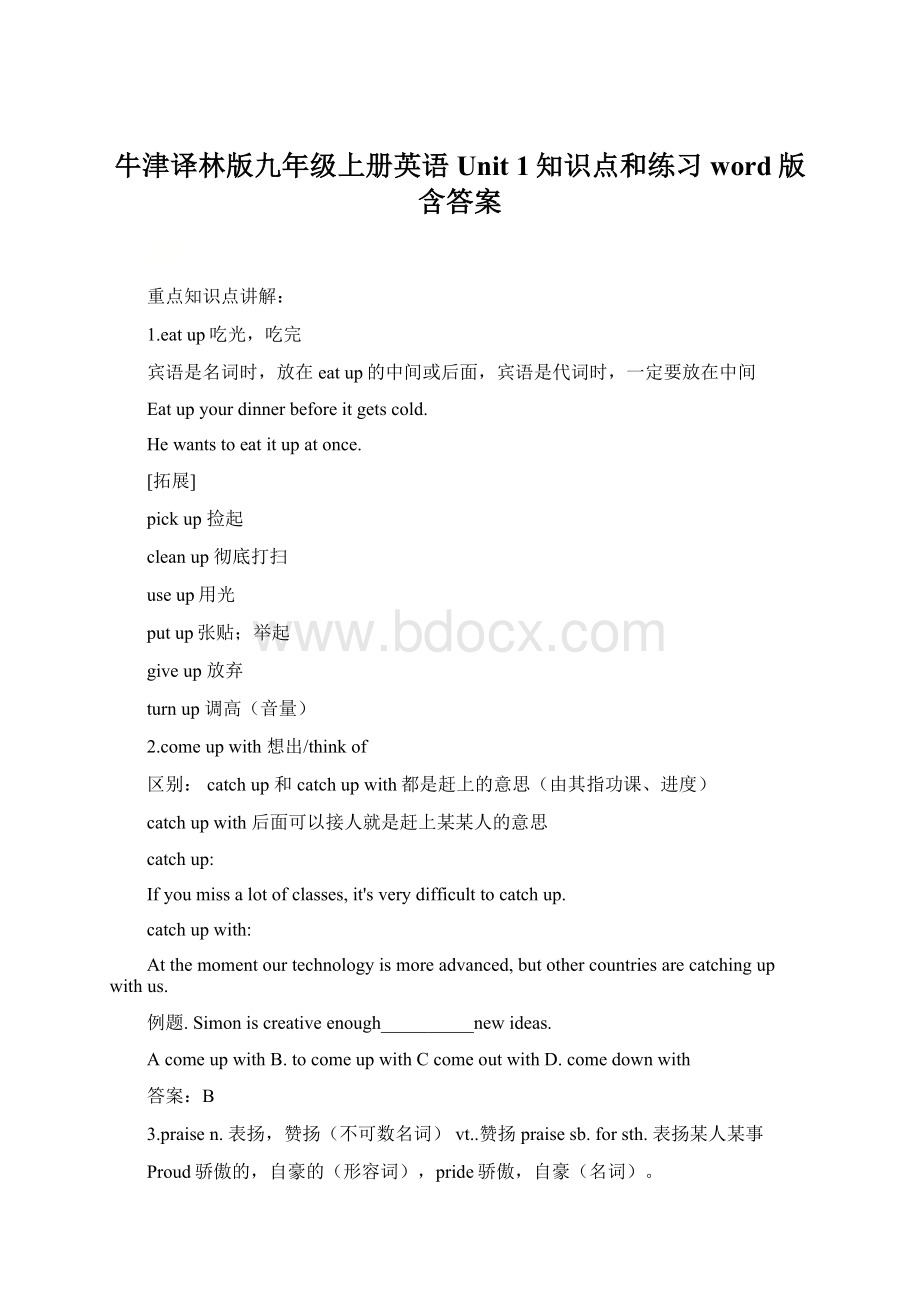牛津译林版九年级上册英语 Unit 1知识点和练习word版含答案.docx
《牛津译林版九年级上册英语 Unit 1知识点和练习word版含答案.docx》由会员分享,可在线阅读,更多相关《牛津译林版九年级上册英语 Unit 1知识点和练习word版含答案.docx(9页珍藏版)》请在冰豆网上搜索。

牛津译林版九年级上册英语Unit1知识点和练习word版含答案
重点知识点讲解:
1.eatup吃光,吃完
宾语是名词时,放在eatup的中间或后面,宾语是代词时,一定要放在中间
Eatupyourdinnerbeforeitgetscold.
Hewantstoeatitupatonce.
[拓展]
pickup捡起
cleanup彻底打扫
useup用光
putup张贴;举起
giveup放弃
turnup调高(音量)
eupwith想出/thinkof
区别:
catchup和catchupwith都是赶上的意思(由其指功课、进度)
catchupwith后面可以接人就是赶上某某人的意思
catchup:
Ifyoumissalotofclasses,it'sverydifficulttocatchup.
catchupwith:
Atthemomentourtechnologyismoreadvanced,butothercountriesarecatchingupwithus.
例题.Simoniscreativeenough__________newideas.
AcomeupwithB.tocomeupwithCcomeoutwithD.comedownwith
答案:
B
3.praisen.表扬,赞扬(不可数名词)vt..赞扬praisesb.forsth.表扬某人某事
Proud骄傲的,自豪的(形容词),pride骄傲,自豪(名词)。
beproudof以...为荣;以...自豪
takepridein以...自豪
同样的意思,但可以看出名词和形容词的用法是有差异的。
形容词前用be动词.
4.attention
payattentionto后面可以直接加名词、代词或者动名词,但是值得我们注意的是,这里的to是一个介词,并不是能构成动词不定式的,这和lookforwardto是一样的。
所以呢,这个词组后面要接动词的话,那麽就要在动词后加ing了。
Payattentiontodoingsth
例句:
1.Wehadpaidattentiontohim.我们已经注意到他了。
(接代词)
2.Theypaidattentiontowatchingthescene.他们注意到了观察现场(接动词+ing)
这个要弄明白的,历年中考都会有这个单词,包括到了高中。
5.devote
(1)devote用作及物动词,意为“把……献给;把……用在”,常与介词to搭配,构成devote...to...结构,介词to之后跟名词或动词-ing形式。
如:
Idon’tthinkweshoulddevoteanymoretimetothisquestion.
我认为我们不应该在这个问题上花更多的时间。
Hedevotedhiswholelifetoteaching.
他把毕生精力献给了教学。
[联想]devotedadj.忠实的
(2)devoteoneselfto致力于,献身于
[例句]Forfouryearshedevotedhimselftomusic.
四年来,他全力倾注于音乐。
Hedevotedhimselftohelpingthepoor.
他献身于帮助穷人。
例题.Thedoctorhasdevotedmostofhistimetothepatients.
A.lookafterB.lookingafterC.looksafterD.lookedafter
答案:
B
[小试]翻译下列句子。
1.你不应该把闲暇时间用在玩电脑游戏上。
_____________________________________
2.王医生致力于癌症的治疗。
_____________________________________
3.医护人员应该致力于照料病人。
_____________________________________
Key:
1.Youshouldn’tdevoteyoursparetimetoplayingcomputergames.
2.Dr.Wangdevotedhimselftothecureforcancer.
3.Doctorsandnursesshoulddevotethemselvestocaringforthesick.
6.agree
agreewithsb/agreeonoraboutsth/agreetodosth
Icouldn'tagreewithyoumore.我非常同意你的看法(注意这是固定句型,助动词必须用couldn't,而不可用can't)
例题.Ihopeyoucan______me.
A.agreewithB.agreeaboutC.agreetoD.agreeon
答案:
A
7.and/but/or/so
and:
和;而且;又;然后
表示联合,意为“和”、“又”、“而且”有时用于连接两个相同的词语,表示事物连续性
Thetrainranfasterandfaster.火车开得越来越快
(1)but用法连词,表示让步关系,意思是“除非,要不是”,常与that一起构成butthat,相当于"if...not"。
例如:
Iwouldhavefailedbutthatyourhelpedme.要不是你们帮助我,我就会失败
(2)but用于否定词加doubt,question,deny等到之后,没有实在意义,只相当于关系连词that.例如:
There'snodoubtbutheisathief.毫无疑问,他是一个贼。
(3)but用作介词,表示“除了”意义,相当于besides,except.例如:
Nooneknowshimbutshe.除了她,没有人认识她。
so:
所以
(1).so可以用作连词,表示“因此,所以”。
例:
Iheardsomenoiseoutside,soIwentoutoftheroomtoseewhy.
sothat作为连词词组,表示“以便,为了”。
例:
Thevaseisputhighonthetable,sothatitwon’tbebroken.
(2)so可以用作副词,表示——
1)“如此,这么”结构为:
so+adj./adv
例:
Shewassotiredthatshefellasleepveryfast.
表示此意思时,还可以用:
so+adj.+a/an+n.
例:
Itissogoodamoviethateveryonewhosawitpraisesitverymuch.
2)“如此,如是”,用于表示已经提到的想法,建议或情况等
例:
“WillIneedmyumbrella?
”
“Ithinkso.”
3)“也是,也一样”结构为so+助动词/情态动词/be动词+主语
例:
Tonytakesexerciseeverydayandsodoeshisyoungerbrother.
注意否定句应把so改为neither/nor,结构为neither/nor+助动词/情态动词/be动词+主语
例:
Jennyhasneverbeenlateforclass.Neither/Norheryoungerbrother.
4)“确实是这样”,表示对前面陈述事实的强调,结构为so+主语+助动词/情态动词/be动词
例:
Tonyworksveryhardatallthesubjects.Sohedoes.
or:
或;否则
Hurryup,oryoullbelate.快点,否则就要迟到了。
这里or表示“否则,不然的话”
Youmaydoityourself,orasksomeoneelsetodoit.你可以自己做,也可以要别人做。
这里or就是表选择。
”或者“的意思。
连接两个成分(名词,短语或句子。
)
Hehardlyevergoestothecinemaorthetheatre.他几乎从来不去电影院或剧院。
这里的or肯定也表示选择了。
例题:
阅读下面的对话,用and,or,but或so填空。
(D=Daniel,S=Suzy)
D:
Howdoyouusuallykilltimeattheweekends?
S:
Iusuallywatchmovies.Moviescanmakemerelaxed,
(1) someofthemmakemethinkalot.
D:
Sodoyouoftengotothecinema?
S:
Well,watchingmoviesinthecinemaisgreatfun,
(2) itcoststoomuch.(3) Iusuallywatchmoviesonmycomputer.
D:
Doyouwatchmoviesalone(4) withyourfriends?
S:
Iusuallywatchthemalone.(5) IoftensharemyideasandfeelingsaboutsomewonderfulmoviesonWeChat.
D:
Don’tyouuseMicroBlog?
It’ssopopularamongus.
S:
MicroBlogispopular,(6) it’slessconvenient(方便的)thanWeChat.Asforcommunication,WeChatismuchfaster,(7) IuseWeChatmoreoftenthanMicroBlog.Howaboutyou?
Whichdoyouusemoreoften,MicroBlog(8) WeChat?
D:
It’shardtosay.Iusebothofthemoften.
答案.1.and2.but3.So
4.or5.But/And6.but
7.so8.or
8.both…and…/notonly…but(also)…/either…or…/neither…nor…
notonly...but(also)...
notonly...but(also)...在句中常用来连接两个对等的成分,also可以省略。
如:
ShespeaksRussiannotonlyinclassbut(also)athome.她在课堂上和家里都说俄语。
notonly...but(also)...用来连接两个主语时,谓语动词的单、复数遵循“就近原则”,即和but(also)后的名词或代词的数一致。
如:
Notonlyyoubutalsoheistiredofhavingoneexaminationafteranother.不但你,而且他也讨厌一次接一次的考试。
notonly...but(also)...连接两个分句,当notonly位于句首,前一个分句常用倒装来表示强调,而but(also)后的分句仍用陈述语序。
如:
NotonlydoesMissLilikemusic,but(also)shelikessports.李小姐不但喜欢音乐,而且还喜欢体育。
【注意】使用中注意两点:
1、就近。
指谓语形式取决于离它近的主语。
NotonlythestudentsbutalsotheteacherreadsEnglisheveryday.
2、一致。
notonly与butalso后面所接的词类要一致。
Shecannotonlysingbutalsodance.
【用法小结】
1.notonly…butalso应连接两个相对称的并列成分。
例如:
NotonlyMrLinbutalsohissonjoinedthePartytwoyearsago.(连接两个主语)
Inotonlyplaytennisbutalsopractiseshooting.(连接两个谓语动词)
Heplaysnotonlythepianobutalsotheviolin.(连接两个宾语)
TheyspeakEnglishnotonlyinclassbutalsointhedormitory.(连接两个地点状语)
【注】
1).Shenotonlysingswellbutalsodancesbeautifully.=Shedoesn'tonlysingwellbutalsodancesbeautifully.
2).句子Henotonlyplaysthepianobutalsotheviolin不是好的文体,因为butalso之后的成分与notonly之后的成分不对称。
2.notonly…butalso连接两个分句,并且notonly位于句首时,第一个分句中的主语和谓语要部分倒装。
例如:
Notonlydoesthesungiveuslightbutalsoitgivesusheat.
NotonlydidhespeakEnglishcorrectly,butalsohespeaksitfluently.
Notonlyisthisyoungmancleverbutalsoheishardworking.
3.notonly…butalso不能用在否定句中。
例如:
误:
Theydon'tfearnotonlyhardshipbutalsodeath.
正:
Theyfearneitherhardshipnordeath.
正:
Theydon'tfeareitherhardshipordeath.
4.notonly…butalso连接两个主语时,谓语动词要和与其最近的主语保持人称和数的一致。
例如:
Notonlythestudentsbutalsotheteacherwasagainsttheplan./Notonlytheteacherbutalsothestudentswereagainsttheplan.
5.notonly…butalso中的notonly不能分开使用,但butalso却可以分开使用。
例如:
Theareawasnotonlyhitbyanunexpectedheavyrain,butsomebridgeswerealsowashedaway.
6.notonly…butalso连接两个并列成分时,可以省略but或also,也可以把butalso都省略掉。
例如:
Inotonlyhearditbut(also)sawit.
Hewasnotonlycompelled(被迫)tostayathome,(but)alsoforbidden(禁止)toseehisfriend.
Shenotonlyfinishedthetaskaheadoftime,(butalso)shecametohelpus.
Neither……nor…/either…..or…/both…and..
both...and指的是两者都是
neither...nor指的是两者都不是(就近远则)
either...or指的是两者之一(就近原则)
neitherof指的是没有一个,三者或三者以上都不是(就近原则)
就近原则指的是be动词和行为动词的用法取决于距离较近的主语的单复数。
就前,是指前面的主语对be动词和行为动词的用法取决定作用。
谓语单和谓语复,是指谓语的单复数形式也是由距离近的主语来决定的。
Forexample:
BothTomandJimaregoodstudents.
NeitherTomnorJimisgoodstudent.
EitherTomorJimisgoodstudent.
Neitherofthemisgoodstudent.
例题:
阅读下面的短文,选择either…or…,both…and…,notonly…butalso…或者neither…nor…填空。
Peoplehavemorechoicesofshoppingnow.Forexample,ifyouwanttobuyabook,youcan
(1) orderoneonline buyoneinabookstore.Moreandmorepeopleprefertodotheshoppingonline.Theysayitsaves
(2) time money.Andtheyhavemorepaymentoptions(支付选择).Theycan(3) payonline paywhentheyreceivethegoods.WiththehelpoftheInternet,(4) peopleinbigcities peopleinthecountrysidecanbuythingsonline.Withaphone,aniPadoracomputer,youcanbuythingswithafewclicks.
Butmyfatherrefusestoshop(5) onaphone onhiscomputer.Hesayshelikestogotostores.“Ifyoubuysomeclothesonline,youcan(6) trythemon feelthemwithhands,”hesays,“It’spossibletobuythingsthatdon’tfityou.Andsometimesthegoodsyoureceiveare(7)
smuggledgoods(水货) copycat(山寨)goods.Whenithappens,(8) yourmoney
yourtimeissaved.”
Ismyfatherright?
Orisheout-of-date?
答案.1.either;or2.both;and/notonly;butalso
3.either;or4.both;and/notonly;butalso
5.either;or6.neither;nor7.either;or
8.neither;nor
【课后作业】
Ⅰ.根据情境和首字母提示,填入恰当的单词完成对话。
(M=Mary,W=Wendy)
M:
CanyoutellmesomethingaboutChineseanimalsigns?
W:
Sure.InourChineselunar
(1)c ,therearetwelveanimalsigns.Eachanimalsignrepresentsayear.
M:
Dothey
(2)a inorder?
W:
Yes.Thereisa(3)f orderlikeacircle.Thecircle(4)r every12years.Andit’ssaidthatpeoplebornunderthesameanimalsignhavesimilarpersonalities.
M:
Itsounds(5)l ourstarsigns.Doyouknowanythingaboutstarsigns?
W:
Yes.Inyourcountry,ayearis(6)d intotwelvestarsigns.Andyourpersonalityis(7)
d byyourstarsign.Right?
M:
You’vegotthepoint.Sodoyoubelieveinanimalsignsorstarsigns?
W:
Tobehonest,Ibelievein(8)n ofthem.IthinknothingbutImyselfcan(9)s mylifeandfuture.
M:
Ican’tagreemore.Whatyouwillbe(10)d onyourself.
Ⅱ.从方框里选择合适的单词或词组,并用其正确形式填空。
say,live,represent,power,practice,mood,forfun,thecase,patient,insomeways
1.Isittruethatpeoplebornunderthesamestarsignarelikeeachother ?
2.Mycousinhasaqui